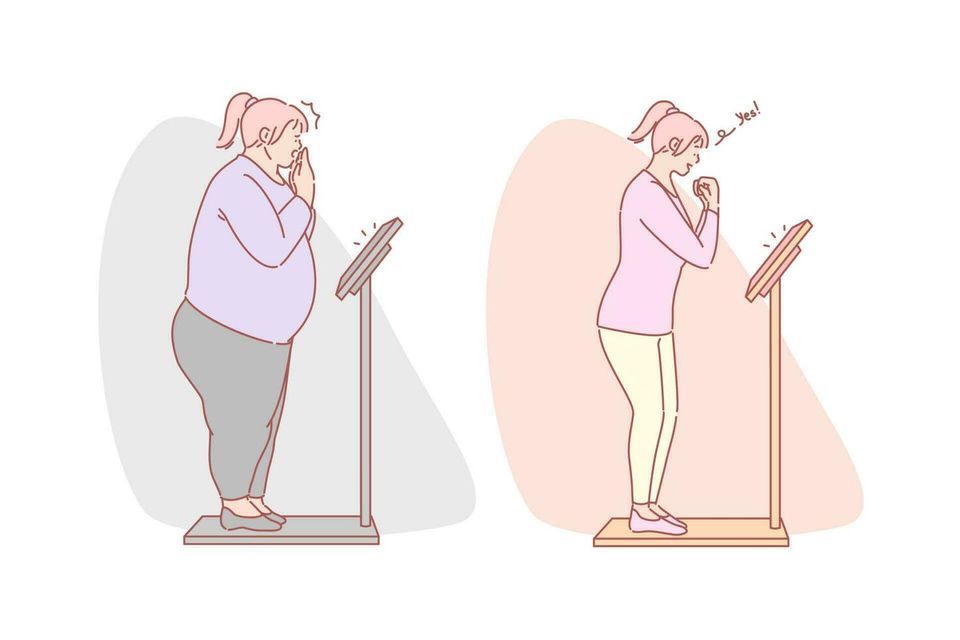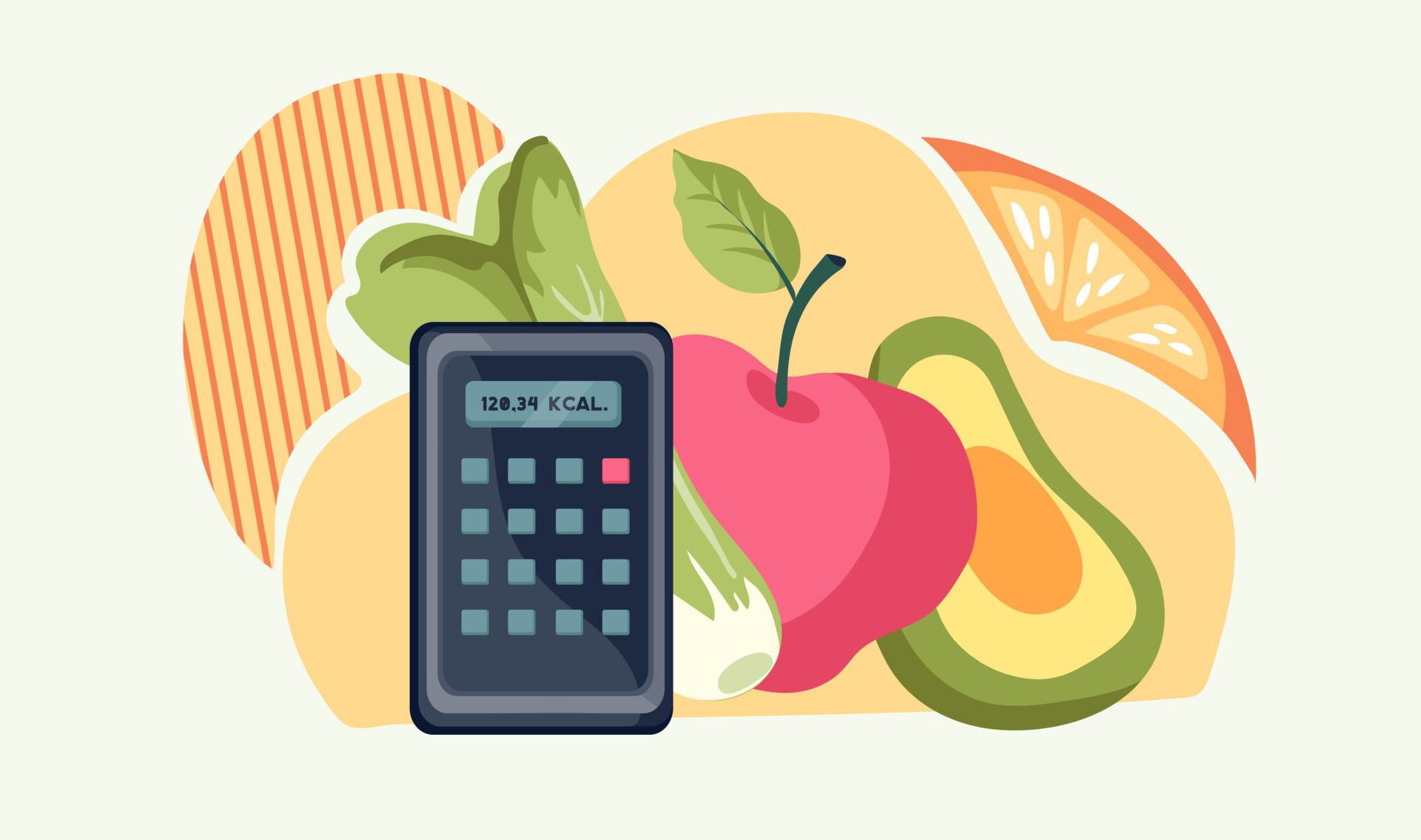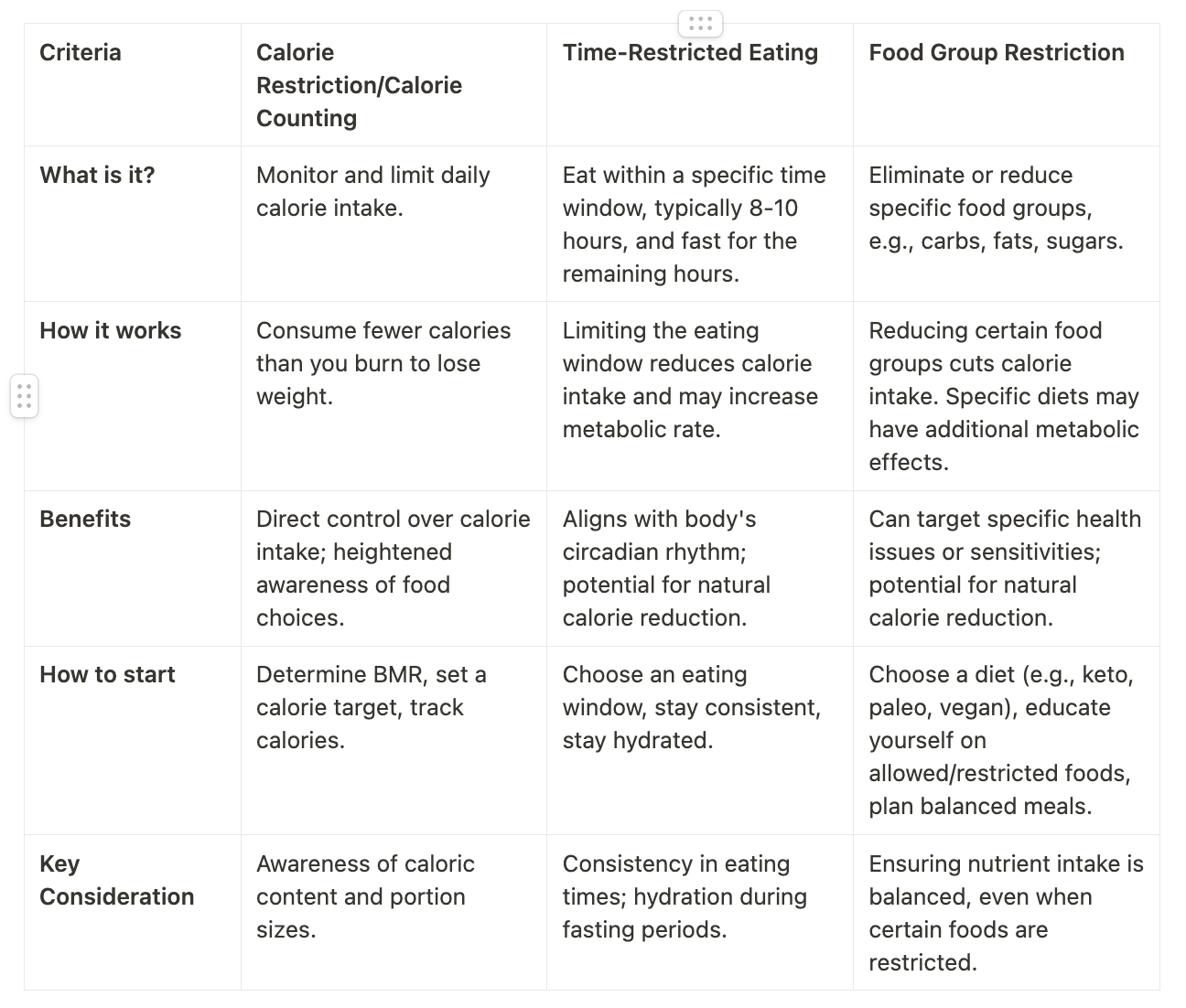The Basics of Fat Loss: Three Main Methods

The Basics of Fat Loss: A Deep Dive into Three Main Methods
Losing fat is a journey that many embark on, but the path isn't always straightforward. With a myriad of methods and advice available, it can be overwhelming to decide which approach to take.
Today, we'll delve into three primary methods of fat loss:
- Calorie restriction,
- Time-restricted eating, and
- Food group restriction.
By understanding the basics, you'll be better equipped to choose the method that aligns with your lifestyle and preferences.
But first some Science...
The Science of Fat Loss: Understanding Energy Intake
At its core, fat loss is a simple equation of energy in versus energy out. Our bodies are constantly burning calories, whether we're running a marathon, typing on a computer, or even sleeping. This energy expenditure is counterbalanced by the energy we gain from the foods we eat.
When we consume more energy (calories) than we expend, our bodies store the excess as fat. Conversely, when we consume fewer calories than we burn, our bodies tap into these fat reserves for the needed energy, leading to fat loss.
While various factors can influence our metabolism and energy expenditure, such as genetics, age, and activity level, the principle remains consistent: energy balance is the cornerstone of weight management. And while there are numerous strategies to achieve a caloric deficit, the key is finding a method that aligns with your lifestyle and preferences.
Let's dive in!
1. Calorie Restriction/Calorie Counting

What is it?
Calorie restriction, more commonly known as calorie counting, is the practice of keeping tabs on the number of calories you consume throughout the day. The underlying principle is straightforward: if you ingest fewer calories than your body expends, you will shed weight.
How does it work?
Every activity, from breathing to running, requires energy. This energy is sourced from the calories we ingest. When our caloric intake surpasses our body's energy requirements, the surplus calories are stored as fat. Conversely, when we limit our caloric intake, our body taps into these fat reserves for energy, resulting in fat loss.
The Learning Curve: A Tool for Awareness
Before diving into the "how-to," it's essential to understand the value of calorie counting beyond mere weight loss. Calorie counting is an enlightening exercise that offers a window into our dietary habits. By tracking calories, you become acutely aware of the caloric content of various foods, the composition of your meals, and the reality of portion sizes.
This awareness is invaluable. It demystifies the often nebulous concept of "eating in moderation" and provides tangible data that can guide healthier food choices.
For this reason, I often recommend everyone to try calorie counting for a few weeks, even if weight loss isn't the primary goal. The insights gained from this exercise can profoundly impact your relationship with food and empower you to make informed dietary decisions.
How to do it:
- Determine your Basal Metabolic Rate (BMR): Your BMR represents the number of calories your body requires to sustain its current weight while at rest. Various online tools and calculators can help you determine this figure.
My go to calculator:https://www.calculator.net/bmr-calculator.html - Set a calorie target: To initiate weight loss, subtract 300-700 calories from your BMR. This caloric deficit will lead to an approximate weight loss of .3-.5 Kg each week, a rate considered safe and sustainable by most health professionals.
- Track your calories: Embrace the habit of logging every morsel you consume. Numerous apps are designed for this very purpose, making it easier than ever to track your intake. If you're more old-school, a simple food journal will suffice. Remember, the goal isn't just to stay within your calorie limit but to cultivate an awareness of your eating patterns.
What I use: https://www.myfitnesspal.com
2. Time-Restricted Eating

What is it?
Time-restricted eating (TRE) is a subset of intermittent fasting, a dietary approach that oscillates between periods of eating and fasting. In TRE, the focus is on confining all caloric intake to a specific timeframe, usually spanning 8-10 hours, and abstaining from caloric consumption for the remaining 14-16 hours of the day.
How does it work?
The mechanics behind time-restricted eating are twofold:
- Caloric Reduction: By narrowing the window of time in which you eat, there's a natural tendency to consume fewer calories overall. This can lead to a caloric deficit, which is essential for weight loss.
- Metabolic Shift: Extended fasting periods trigger a series of physiological changes. The body, in the absence of readily available glucose from food, begins to tap into glycogen stores. Once these are depleted, the body shifts to burning stored fat for energy. Additionally, fasting can lead to increased levels of norepinephrine and a decrease in insulin levels, both of which can boost metabolic rate and further fat burning.
The Science of Synchronization:
Beyond weight loss, TRE aligns with our body's circadian rhythm, the internal clock that regulates sleep-wake cycles, hormone release, and other physiological processes. By eating in sync with our natural rhythm, we might optimize digestion, hormone balance, and energy utilization.
How to do it:
- Choose your eating window: The specific window you select will depend on your lifestyle and preferences. Common choices include 12pm-8pm or 10am-6pm. Some individuals prefer an earlier window, like 8am-4pm, to align better with the body's circadian rhythm.
- Stay consistent: As with any habit, consistency is key. By eating at consistent times, you not only train your body to expect food during these periods, but you also reinforce the habit, making it easier to stick to in the long run.
- Stay hydrated: During fasting periods, it's crucial to maintain hydration. Water aids in digestion, nutrient absorption, and temperature regulation. While caloric beverages break the fast, non-caloric drinks like water, unsweetened tea, or black coffee are permissible and encouraged.
- Listen to your body: While TRE can offer numerous benefits, it's essential to tune into your body's signals. If you feel overly fatigued, dizzy, or experience other adverse effects, consider adjusting your eating window or consulting with a healthcare professional.
In conclusion, time-restricted eating is more than just a weight loss tool; it's a holistic approach that considers the body's natural rhythms and metabolic processes. As with any dietary strategy, individual experiences may vary, so it's essential to find a routine that feels sustainable and beneficial for you.
3. Food Group Restriction

What is it?
Food group restriction is a dietary approach that involves limiting or entirely eliminating certain food groups from one's diet. This can range from cutting out specific macronutrients, like carbohydrates or fats, to avoiding particular food categories, such as dairy or grains.
How does it work?
The rationale behind food group restriction varies based on the group being restricted:
- Carbohydrates: When carbs are limited, the body enters a state called ketosis. In this state, the body burns fat for fuel instead of its usual energy source, glucose. This can lead to rapid fat loss, especially in the initial stages.
- Fats: Reducing fat intake can significantly cut calorie consumption since fats are the most calorie-dense macronutrient, providing 9 calories per gram compared to 4 calories per gram for both proteins and carbohydrates.
- Sugars: Cutting out added sugars can lead to a natural reduction in calorie intake. Moreover, reducing sugar can stabilize blood sugar levels, reducing insulin spikes and promoting fat burning.
The Broader Picture:
Beyond calorie reduction, food group restriction can have other health benefits. For instance, some people restrict certain food groups due to allergies, intolerances, or to reduce inflammation.
How to do it:
- Choose a diet: The diet you select should align with your goals, health needs, and lifestyle.
- Ketogenic Diet: Focuses on high fat, moderate protein, and very low carbohydrate intake.
- Paleo Diet: Emphasizes whole foods, lean meats, fish, fruits, vegetables, and nuts while excluding grains, dairy, and processed foods.
- Vegan Diet: Excludes all animal products, focusing on plant-based foods.
- Educate yourself: Before diving into any restrictive diet, it's crucial to understand its nuances. Research which foods are permissible and which are off-limits. Familiarize yourself with potential health benefits and risks.
- Plan meals: Restricting food groups can make it challenging to get all the essential nutrients. Planning is paramount. Ensure your meals are balanced and provide all the necessary vitamins and minerals. Consider consulting with a nutritionist or dietitian to ensure you're meeting all your nutritional needs.
- Monitor your body's response: As you embark on this journey, pay close attention to how your body reacts. Are you feeling more energetic, or are you lethargic? Is your digestion better or worse? These cues can help you tailor the diet to better suit your needs.
In summary, food group restriction can be an effective way to lose weight and improve overall health. However, it's essential to approach it with knowledge and intentionality, ensuring that you're nourishing your body adequately while pursuing your dietary goals.
In Conclusion
While each of these methods has its merits, no single approach is universally superior. The effectiveness of a fat loss method largely depends on individual adherence.
Remember, the best strategy is the one you can stick to consistently. Your journey to fat loss is personal, and the key to success lies in finding a method that aligns with your lifestyle, preferences, and goals. So, take a moment to reflect on your journey, choose your path, and thrive on!
Here's a cheat sheet in table form that breaks down each of the three methods:

Taking the Next Step in Your Health Journey
Navigating the world of nutrition and weight loss can be a daunting task, especially with the plethora of information available. But remember, you don't have to embark on this journey alone. If you're feeling uncertain about where to begin or how to optimize these methods for your unique needs, I'm here to help.
Whether you're looking to dive deeper into one of these methods or seeking a holistic approach tailored to your lifestyle, together we can chart a path forward. Reach out today, and let's collaborate to elevate your health and well-being to unparalleled heights.